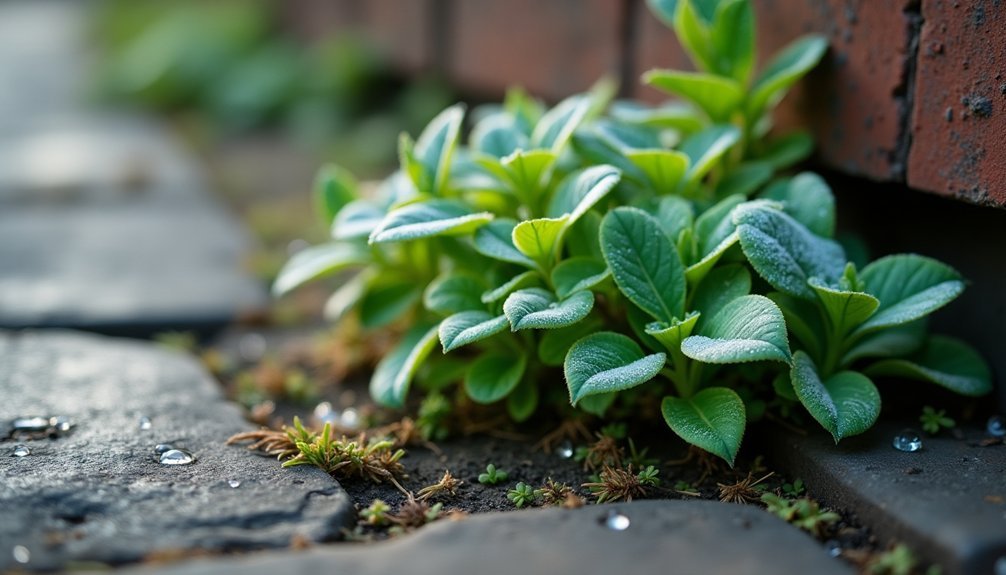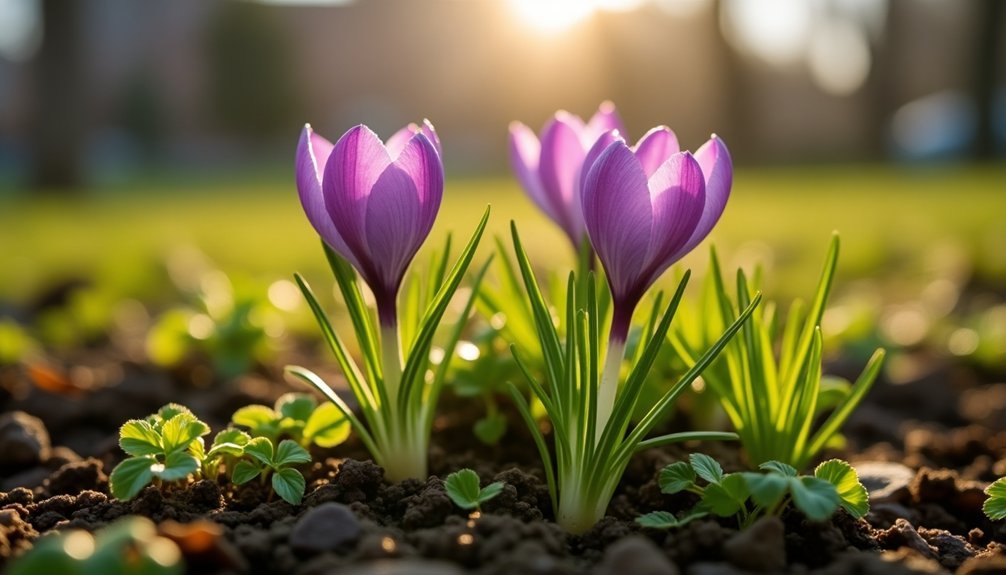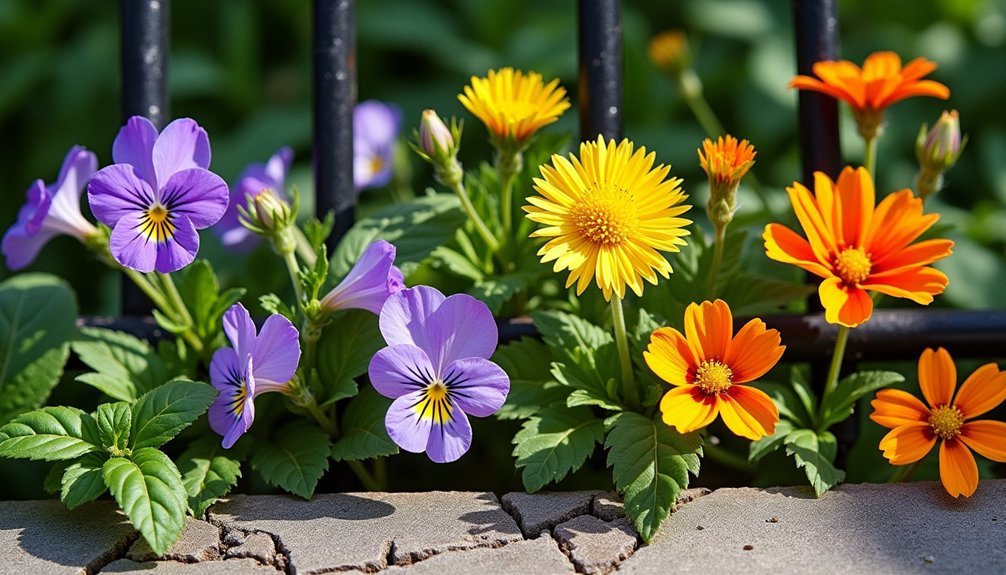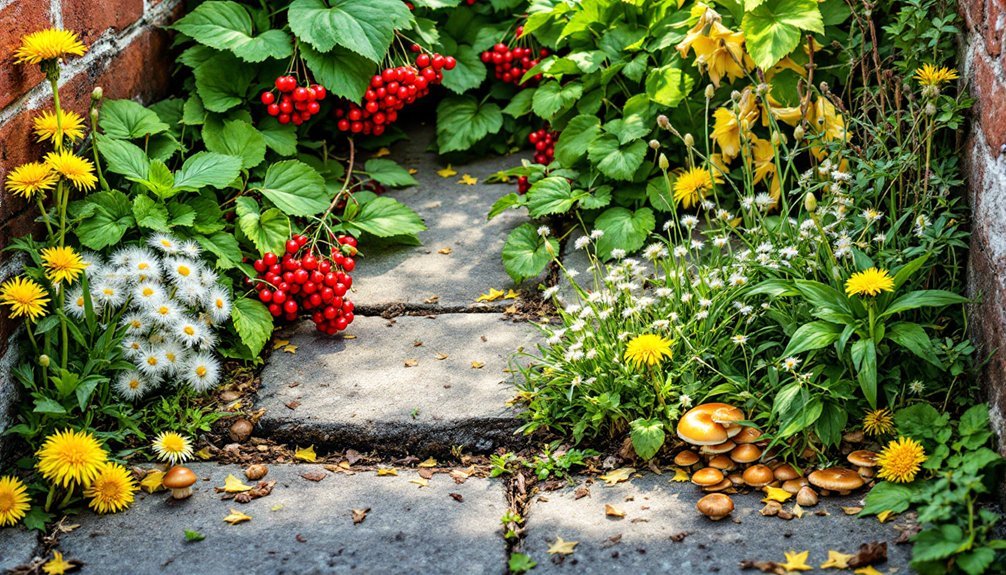Urban foraging offers year-round treasures if you know where to look. January brings nutrient-rich dandelions and chickweed, while February welcomes early sprouts like cleavers. Spring reveals wild garlic, edible flowers, and herbs, followed by summer's berry bounty in urban green spaces. Fall rewards you with nuts, seeds, and mushrooms. Always verify plant identification, check local regulations, and harvest responsibly. Discover how each month presents unique foraging opportunities in your concrete jungle.
January: Winter Greens in the Concrete Jungle

While most people assume winter turns cities into food deserts, January actually offers a surprising bounty of wild edibles thriving in urban environments.
You'll find nutrient-rich dandelions, chickweed, and plantain in parks and vacant lots—often containing more vitamins than their grocery store counterparts.
Before you harvest, check local regulations and avoid areas near roads or those potentially sprayed with chemicals.
Once you've gathered your greens, try sautéing them in oil, adding them to soups, or mixing them in salads. January's greens can be bitter, so balance them with sweeter ingredients. These wild greens are often healthier and contain lost nutrition reclaimed that has been bred out of commercially cultivated vegetables.
Beyond nutrition, urban foraging reduces waste, supports biodiversity, and connects you with your environment—all while providing fresh produce during winter's coldest month.
February: Early Sprouts Among Urban Landscapes
As February's milder days coax the first edible sprouts from urban soils, you'll find winter gems like cleavers and sea beet emerging in city parks and along towpaths.
When identifying these early treasures, you must exercise caution as many edible plants have dangerous lookalikes that can cause serious harm if consumed.
Always use plant identification apps or consult foraging guides to verify your finds before adding them to your basket, especially when distinguishing between wild garlic and toxic relatives.
Common mallow can be readily found in February and has been used as a nutritious green since 3,000 BC, with its leaves suitable for cooking like spinach or adding to soups.
Winter Gems Emerge
Despite winter's firm grip, February marks the subtle awakening of urban landscapes as early foragers discover nature's first offerings.
Look for chickweed thriving in garden edges and parklands, providing exceptional nutritional value even in cold conditions. Its mild flavor and fine stem hairs make it easy to identify correctly when foraging in urban settings.
Wild garlic sprouts begin to emerge in wooded areas and along river banks, identifiable by their distinctive aroma before you even see them.
The vibrant scarlet elf cup mushroom creates splashes of color among fallen branches in urban forests.
You'll also find stinging nettles at their nutritional peak during these cooler months.
Lesser celandine's early flowers signal the approaching spring change.
These urban winter treasures not only connect you to nature in concrete environments but offer free, nutrient-dense alternatives to store-bought produce while reducing your carbon footprint.
Toxic Lookalike Warnings
For every edible urban plant that emerges in February, a dangerous doppelgänger often lurks nearby. As you venture out, be particularly vigilant about hemlock, which fatally mimics wild carrot with its similar feathery leaves. Never harvest unless you're 100% certain of identification.
Wild parsnip causes severe skin reactions when exposed to sunlight, while poison ivy's three-leaf clusters can be easily confused with harmless vines during early growth.
Remember that true morels are hollow inside, while false morels contain solid chambers and are toxic. Distinguish between purslane and toxic spurge by checking for clear versus milky sap when breaking the stem.
Always wear gloves when investigating unfamiliar plants, use field guides or reliable plant identification apps, and avoid foraging in polluted areas near roads or industrial zones.
When in doubt, consult local experts or botanical societies before consuming any urban finds.
March: Spring Awakening in City Parks

When the first hints of green emerge from beneath winter's blanket, city parks transform into treasure troves for urban foragers.
March offers dandelions with their nutritious leaves and flowers, perfect for salads or as a coffee substitute. Look for dead nettle too—it tastes similar to spinach and is often overlooked.
You'll find chives and wild onions among the earliest sprouts in urban lawns, adding flavor to spring dishes. These wild edibles can be harvested while waiting for community tree planting events that typically begin in late March.
Don't miss plantain, commonly growing in pathways and easily identified by its parallel-veined leaves.
When foraging, always carry scissors and gloves, identify plants with certainty, and harvest respectfully by taking only what you need.
Remember to get permission in managed parks and leave roots intact to guarantee these wild foods return next season.
April: Urban Wild Garlic and Spring Blooms
As April arrives, city green spaces burst with wild garlic's distinctive aroma, signaling prime foraging season for urban gatherers. This versatile plant thrives in churchyards, parks, and ancient woodlands, with every part—from leaves to bulbs—being edible.
When harvesting, remember to take only what you need and avoid damaging root structures to promote future growth. Always be 100% certain of your identification, using reliable resources like "Food For Free" by Richard Mabey.
Check that your foraging spots haven't been sprayed with pesticides and obtain permission when necessary. Sturdy scissors and a plastic bag are ideal collection tools for gathering wild garlic without damaging the plants. Churchyards and public green spaces often offer the richest pickings this month, while personal backyards may surprise you with edible treasures like dandelions.
Join local foraging groups for expert guidance on sustainable practices.
May: Edible Flowers and Herbs in Metropolitan Areas

Spring's abundance reaches its peak in May, transforming urban landscapes into foragers' paradises filled with edible flowers and herbs.
City parks, waste grounds, and hedgerows become treasure troves of edible delights. Look for young, heart-shaped leaves from lime trees, which offer a sweet flavor and can be added to salads or sandwiches with a squeeze of lemon juice.
Look for these urban foraging highlights:
- Mallow flowers and leaves offer protein, calcium, and iron—perfect additions to salads or sauces.
- Hawthorn's almond-scented flowers and young leaves make delicious salad ingredients.
- Oxeye daisies found along verges provide edible petals for brightening desserts.
- Chickweed growing in collaborative gardens delivers versatile greens for salads and teas.
Always forage responsibly: identify plants with multiple sources, avoid polluted areas, harvest sustainably, and get proper permission.
Remember to leave plenty for wildlife and local ecosystems.
June: Summer Berries Along City Trails
June heralds the arrival of nature's sweetest urban treasures—wild berries. As you explore city trails, you'll find wild strawberries in green spaces, blackberries along canal banks, and blueberries near wetlands. This foraging season is limited, so be sure to take advantage of the abundance while it lasts.
| Berry Type | Where to Find | When to Pick |
|---|---|---|
| Wild Strawberry | Urban green spaces | Early June |
| Blackberry | River banks, canals | Mid-late June |
| Wineberry | Urban woodlands | Late June |
| Raspberry | Woodland edges | Mid-June |
Remember safety while foraging: avoid areas near roads, properly identify berries, and check local regulations. Bring essential tools like field guides, foraging baskets, and gloves to protect your hands. Once home, transform your harvest into jams, crisps, or freeze them for future smoothies and desserts.
July: Peak Harvest in Urban Green Spaces
July transforms city green spaces into veritable pantries for urban foragers, offering the year's most abundant and diverse harvests.
You'll find serviceberries and wild strawberries at their peak, with blackberries and raspberries beginning to ripen along trails and fence lines.
When you're exploring urban parks this month:
- Look for wild grape vines climbing fences or trees – their young leaves are edible and the developing fruit clusters signal future harvests.
- Identify elderberry bushes by their flat white flower clusters transforming into berries.
- Harvest staghorn sumac's red berry clusters for making invigorating lemonade-like drinks.
- Search neglected areas where fruit trees may have been planted years ago.
Foraging in these urban environments allows you to discover unique flavors not typically found in commercially available produce.
Remember to harvest sustainably, leaving plenty for wildlife and future foragers.
August: Heat-Loving Plants in Forgotten Corners
As summer heat intensifies in August, a new foraging opportunity emerges in the overlooked corners of urban landscapes. This is when heat-loving plants like passionfruit vines and Armenian cucumbers thrive on abandoned trellises and structures, offering nutritious yields with minimal competition. Passionfruit vines not only provide delicious fruit but their flowers can be used for making calming teas that help reduce anxiety.
Look for zinnias and hollyhocks in churchyards and towpaths—their edible flowers attract pollinators and add color to your foraging basket. Established citrus trees in community gardens or abandoned areas may be heavy with fruit during this period.
The vibrant blooms of zinnias and hollyhocks offer both visual delight and culinary potential in places where city meets nature.
Always bring gloves and a basket when exploring these forgotten spaces, and be mindful of pollution near industrial zones. Before harvesting, check local regulations and seek permission where needed.
Remember to document your finds using apps like iNaturalist for future reference.
September: Autumn Nuts and Seeds in Local Parks
When September's cooling temperatures signal autumn's arrival, urban parks transform into treasure troves of nutritious nuts and seeds.
Oak trees drop acorns abundantly, while hickory trees offer their prized nuts in certain regions. You'll even find black walnuts in some areas, though they require extra effort to process. These nuts provide essential oils and proteins for both humans and wildlife.
Four essential tips for urban nut foraging:
- Start with acorns – They're plentiful in city parks but need proper leaching to remove tannins.
- Identify varieties carefully – Not all hickory nuts taste good, and proper identification guarantees palatability.
- Share with wildlife – Take only what you need, leaving enough for squirrels and birds preparing for winter.
- Check for contamination – Avoid collecting near busy roads or potentially treated areas.
October: Fall Mushrooms and Root Vegetables
October's damp soil and crisp air create perfect conditions for urban foragers seeking mushrooms and root vegetables.
In city parks and woodland edges, you'll find chanterelles with their distinctive apricot aroma, while fallen logs often host clusters of oyster mushrooms.
When mushroom hunting, always carry a proper identification guide and basket.
Never consume fungi you can't identify with absolute certainty, particularly avoiding Amanita species.
This month is also ideal for harvesting nutrient-rich roots.
Dig for dandelion roots in green spaces for homemade coffee substitutes, or seek out burdock with its earthy flavor.
Don't overlook Jerusalem artichoke tubers with their sweet, nutty taste – perfect for roasting.
Remember to obtain permission when foraging on private property and follow local regulations in public areas.
While exploring, consider collecting rosehips which are common in hedgerows and make excellent vitamin-rich teas and syrups.
November & December: Winter Foraging Survival Guide
Winter's arrival in November and December transforms urban foraging, presenting both challenges and unique opportunities.
Despite the colder temperatures, you'll find surprising abundance if you're properly prepared with warm waterproof clothing and reliable identification tools.
Urban environments offer several winter foraging treasures:
- Vitamin-rich finds – Rose hips and hawthorn berries provide essential nutrients when fresh produce is scarce.
- Medicinal mushrooms – Turkey tail mushrooms boost immunity during cold season.
- Versatile roots – Dig for burdock and dandelion roots for food and medicinal uses.
- Evergreen offerings – Pine needles and juniper berries add flavor to seasonal dishes.
Remember to follow animal tracks to discover protected foraging spots, and always harvest responsibly, leaving plenty for wildlife that depends on these resources through winter. It's crucial to forage in small quantities, especially when trying new plants for the first time to ensure your body responds well.
Frequently Asked Questions
How Can I Safely Forage Near Industrial or Potentially Contaminated Areas?
You can't safely forage near industrial areas. Avoid these locations completely due to heavy metals, chemicals, and contaminants. Instead, seek out tested community gardens or parks away from roads and pollution sources.
Which Foraged Foods Are Best for Beginner Urban Foragers?
Start with easily identifiable plants like dandelions, wild garlic, and plantain. They're abundant in urban areas, nutritious, and hard to confuse with toxic look-alikes. Use plant identification apps to confirm your finds.
How Do I Preserve Excess Foraged Finds Throughout the Year?
You'll preserve your excess foraged foods best by freezing berries, drying herbs, canning fruits, pickling vegetables, or fermenting greens. Rotate your preservation methods based on what you've collected and your available storage space.
Are There Toxic Urban Lookalikes I Should Be Especially Careful About?
Yes, you'll need to watch for hemlock (has purple-spotted stems) and wild parsnip that mimic edible plants. Also avoid horse nettle and Jerusalem cherry, which look like wild tomatoes but are toxic.
Can Urban Foraging Provide Enough Nutrition for a Supplementary Diet?
Yes, you can greatly supplement your diet through urban foraging. Foraged foods often contain higher nutrients than store-bought alternatives, providing essential vitamins, minerals, and antioxidants that contribute to your overall nutritional needs and dietary diversity.
In Summary
You're now equipped to transform your city walks into foraging expeditions throughout the year. Remember, it's not just about free food—you're connecting with nature, even in the midst of concrete and steel. Always forage responsibly, respect public spaces, and check local regulations. The urban landscape is full of edible treasures waiting for you to discover them, no matter the season.





Leave a Reply